
As if any of us needed a reminder, the last few days showed us how quickly things can change. A month ago—or even a week ago—no one knew quite how different our day-to-day lives would be. Suddenly, kids are out of school, parents are working from home, and the way we socialize and interact with each other has seismically shifted. Now more than ever, families need to feel confident in their technology—which has been helping us stay connected when we can’t physically be together. And because tech is a crucial lifeline right now, it’s important that parents feel empowered when using it with their kids. Now more than ever, we need to rely on technology to socialize, spur our creativity and help us continue learning.
Earlier this year, I published my first book
Screen Captured, a resource that helps families navigate technology. In it, I looked at a few of the less positive ways tech has affected our lives, but the major message (and the one I think is so important right now) is that apps, platforms and devices have the potential for so much good.
A deep dive into the literature

I arrived at writing in a roundabout way as I was doing research for
Kinzoo, the kid-tech company I founded in 2018. Back then, one of the biggest concerns about technology was around the addictive nature of some apps and platforms—and many of the tech world’s founders were speaking candidly about the manipulative features they had built (intentionally or otherwise) into their products. I read books like Adam Alter’s
Irresistible: The Rise of Addictive Technology and began learning how apps are designed to keep us screen captured. I felt I had to learn everything I could about the ways tech could go wrong so we didn’t inadvertently include addictive or manipulative features in Kinzoo. So down the rabbit hole I went, devouring as many resources and studies as I could—and it took a while before I started to feel like I had a foothold on the topic.
In the course of researching, I’d implemented a few changes around tech use in my own household. We used to “timestamp” tech with my kids, imposing limits on total screen time, but we started to find it more useful to think critically about what the kids were doing instead of focusing only on duration. And, now that my kids are home from school, the idea of screen time limits are the last thing on our minds. Sure, we still have rules and structures in place, but we’re not beating ourselves up if we’re relying a little more heavily on screens than we did last week.
After writing my book—and indeed today—I’m more confident than ever that tech will be a positive force for my kids. But, I know not every parent eats, sleeps and breathes tech like I do, and I recognize that many families could probably benefit from the legwork I’d done while building Kinzoo.
Empowering families to talk about tech
I always used to say, “technology isn’t coming, it’s here.” And boy, does that ring true now! We’re all using tech in new ways to check in on loved ones, work and learn remotely—and entertain ourselves. But, parents still probably have questions about how to integrate it into their family’s lives.
Screen Captured is not a step-by-step guide, and that’s quite intentional. I’m not a psychologist or professional researcher, but I am a dad with stories about my own lived experience introducing tech to my daughter. For me, this book isn’t about telling parents what to do. Rather, it’s about sharing what I’d learned on this journey—and hopefully equipping others to have productive conversations about the role of technology in their families. It’s about pulling back the curtain on the tech industry and bringing some transparency to the way apps and platforms operate—and what that means for our kids.
My hope is that
Screen Captured can be a tool to help parents cut through the noise and gain the confidence to tell good tech from bad. In it, I spell out the difference between positive screen time—which is educational, creative and connecting—and screen capture, which uses manipulative mechanisms to keep us scrolling ad infinitum. All the research that I did really helped to simplify the role of technology in my household, and has made it a much less contentious subject with my kids. I think the book can do the same for other parents, and I’m really excited by that.
When I first published
Screen Captured, I shared an advanced copy of the audiobook with a friend and fellow parent. She listened to it one chapter at a time with her kids on their drive to school, and she shared some interesting insights: it’s prompted her son to share stories about how he and his friends use tech, and it’s inspired her daughter to experiment with phone-free time during the day. She noted that sharing the book with her kids (as opposed to reading it and relaying the information), opened up a collaborative conversation in her family around tech use.
There’s no denying it—we’re facing a lot of uncertainty right now. Things aren’t the same as they were last week, and we don’t know what next week will look like. If I could go back in time and make any changes to
Screen Captured, I would double down on my message that screens can be a force for good. I think parents need to hear that on repeat right now, because screens will inevitably be a more prominent part of our lives, at least for a little bit. If ever there was a moment to throw time stamping out the window, surely it’s now. Whatever helps you and your family stay happy, healthy and connected, do it. And do it with confidence.
 Sean Herman is the founder of Kinzoo, a video-sharing app where children can connect and parents can be sure they’re safe. Kids use Kinzoo to access the best of what technology has to offer: empowering creativity, connecting with friends and family and learning about the things they love within closed, managed communities.
Sean Herman is the founder of Kinzoo, a video-sharing app where children can connect and parents can be sure they’re safe. Kids use Kinzoo to access the best of what technology has to offer: empowering creativity, connecting with friends and family and learning about the things they love within closed, managed communities.
 As if any of us needed a reminder, the last few days showed us how quickly things can change. A month ago—or even a week ago—no one knew quite how different our day-to-day lives would be. Suddenly, kids are out of school, parents are working from home, and the way we socialize and interact with each other has seismically shifted. Now more than ever, families need to feel confident in their technology—which has been helping us stay connected when we can’t physically be together. And because tech is a crucial lifeline right now, it’s important that parents feel empowered when using it with their kids. Now more than ever, we need to rely on technology to socialize, spur our creativity and help us continue learning.
Earlier this year, I published my first book Screen Captured, a resource that helps families navigate technology. In it, I looked at a few of the less positive ways tech has affected our lives, but the major message (and the one I think is so important right now) is that apps, platforms and devices have the potential for so much good.
As if any of us needed a reminder, the last few days showed us how quickly things can change. A month ago—or even a week ago—no one knew quite how different our day-to-day lives would be. Suddenly, kids are out of school, parents are working from home, and the way we socialize and interact with each other has seismically shifted. Now more than ever, families need to feel confident in their technology—which has been helping us stay connected when we can’t physically be together. And because tech is a crucial lifeline right now, it’s important that parents feel empowered when using it with their kids. Now more than ever, we need to rely on technology to socialize, spur our creativity and help us continue learning.
Earlier this year, I published my first book Screen Captured, a resource that helps families navigate technology. In it, I looked at a few of the less positive ways tech has affected our lives, but the major message (and the one I think is so important right now) is that apps, platforms and devices have the potential for so much good.
 I arrived at writing in a roundabout way as I was doing research for Kinzoo, the kid-tech company I founded in 2018. Back then, one of the biggest concerns about technology was around the addictive nature of some apps and platforms—and many of the tech world’s founders were speaking candidly about the manipulative features they had built (intentionally or otherwise) into their products. I read books like Adam Alter’s Irresistible: The Rise of Addictive Technology and began learning how apps are designed to keep us screen captured. I felt I had to learn everything I could about the ways tech could go wrong so we didn’t inadvertently include addictive or manipulative features in Kinzoo. So down the rabbit hole I went, devouring as many resources and studies as I could—and it took a while before I started to feel like I had a foothold on the topic.
In the course of researching, I’d implemented a few changes around tech use in my own household. We used to “timestamp” tech with my kids, imposing limits on total screen time, but we started to find it more useful to think critically about what the kids were doing instead of focusing only on duration. And, now that my kids are home from school, the idea of screen time limits are the last thing on our minds. Sure, we still have rules and structures in place, but we’re not beating ourselves up if we’re relying a little more heavily on screens than we did last week.
After writing my book—and indeed today—I’m more confident than ever that tech will be a positive force for my kids. But, I know not every parent eats, sleeps and breathes tech like I do, and I recognize that many families could probably benefit from the legwork I’d done while building Kinzoo.
I arrived at writing in a roundabout way as I was doing research for Kinzoo, the kid-tech company I founded in 2018. Back then, one of the biggest concerns about technology was around the addictive nature of some apps and platforms—and many of the tech world’s founders were speaking candidly about the manipulative features they had built (intentionally or otherwise) into their products. I read books like Adam Alter’s Irresistible: The Rise of Addictive Technology and began learning how apps are designed to keep us screen captured. I felt I had to learn everything I could about the ways tech could go wrong so we didn’t inadvertently include addictive or manipulative features in Kinzoo. So down the rabbit hole I went, devouring as many resources and studies as I could—and it took a while before I started to feel like I had a foothold on the topic.
In the course of researching, I’d implemented a few changes around tech use in my own household. We used to “timestamp” tech with my kids, imposing limits on total screen time, but we started to find it more useful to think critically about what the kids were doing instead of focusing only on duration. And, now that my kids are home from school, the idea of screen time limits are the last thing on our minds. Sure, we still have rules and structures in place, but we’re not beating ourselves up if we’re relying a little more heavily on screens than we did last week.
After writing my book—and indeed today—I’m more confident than ever that tech will be a positive force for my kids. But, I know not every parent eats, sleeps and breathes tech like I do, and I recognize that many families could probably benefit from the legwork I’d done while building Kinzoo.
 Sean Herman is the founder of Kinzoo, a video-sharing app where children can connect and parents can be sure they’re safe. Kids use Kinzoo to access the best of what technology has to offer: empowering creativity, connecting with friends and family and learning about the things they love within closed, managed communities.
Sean Herman is the founder of Kinzoo, a video-sharing app where children can connect and parents can be sure they’re safe. Kids use Kinzoo to access the best of what technology has to offer: empowering creativity, connecting with friends and family and learning about the things they love within closed, managed communities.